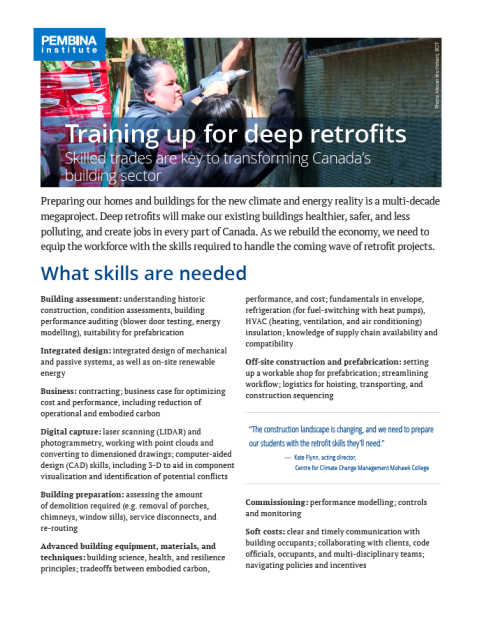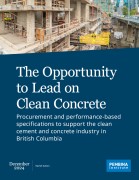Preparing our homes and buildings for the new climate and energy reality is a multi-decade megaproject. Deep retrofits will make our existing buildings healthier, safer, and less polluting, and create jobs in every part of Canada. As we rebuild the economy, we need to equip the workforce with the skills required to handle the coming wave of retrofit projects.
Download the backgrounder, or keep reading below.
Find more resources to help local governments accelerate deep retrofits.
What skills are needed
Building assessment: understanding historic construction, condition assessments, building performance auditing (blower door testing, energy modelling), suitability for prefabrication
Integrated design: integrated design of mechanical and passive systems, as well as on-site renewable energy
Business: contracting; business case for optimizing cost and performance, including reduction of operational and embodied carbon
Digital capture: laser scanning (LIDAR) and photogrammetry, working with point clouds and converting to dimensioned drawings; computer-aided design (CAD) skills, including 3-D to aid in component visualization and identification of potential conflicts
Building preparation: assessing the amount of demolition required (e.g. removal of porches, chimneys, window sills), service disconnects, and re-routing
Advanced building equipment, materials, and techniques: building science, health, and resilience principles; tradeoffs between embodied carbon, performance, and cost; fundamentals in envelope, refrigeration (for fuel-switching with heat pumps), HVAC (heating, ventilation, and air conditioning) insulation; knowledge of supply chain availability and compatibility
Off-site construction and prefabrication: setting up a workable shop for prefabrication; streamlining workflow; logistics for hoisting, transporting, and construction sequencing
Commissioning: performance modelling; controls and monitoring
Soft costs: clear and timely communication with building occupants; collaborating with clients, code officials, occupants, and multi-disciplinary teams; navigating policies and incentives
How governments and institutions can help
Post-secondary institutions
• Initiate deep retrofit courses through continuing education programs, which can be more flexible and provide various levels of certifications to an active labour force.
• Supplement diploma coursework with deep retrofit courses and differentiate students with additional recognition of their retrofit specialty.
• Extend the retrofit specialty designation to diploma programs — such as information technology, business, health, and community services — that provide supporting structures for successful housing programs.
• Incorporate retrofits into living lab opportunities.
Local governments and First Nations
• Collaborate with industry associations and other governments, including other communities in the region, and direct resources to training of the local labour force.
• Provide existing building inspection and permitting staff with training in high-performance retrofits to ensure they keep up with new methods and technologies.
• Fine-tune hiring processes to build expertise by requiring retrofit training credits or certificates.
• Engage fire departments to ensure local retrofit training is designed to align with health and safety codes.
Provincial and territorial governments
• Collaborate with post-secondary institutions and high-performance building centres to develop and support hands-on training spaces equipped with high-performance assemblies and technologies, including retrofit mock-ups.
• Leverage existing retrofit training programs, such as LEEP (Local Energy Efficiency Partnerships), and work with industry associations to deliver them to people across the province.
• Use public buildings and social housing as deep retrofit learning labs.
Federal government
• Work with industry and education institutions to develop national training standards for high-efficiency equipment and envelope installation.
• Develop a retrofitter accreditation program to facilitate hiring and trade selection.
• Broaden access to LEEP training by creating a national professional development framework for accredited trades and professions.
Where training is happening
Peer-to-peer
• LEEP Renovation Forums, Canada Green Building Council
• Home Performance Stakeholder Council (B.C.)
• Endeavour Centre (Peterborough, Ont.)
• Ecology Action Centre (Halifax)
On the job
• ERA Architects, CityHousing Hamilton
• Butterwick, Sundance Housing Co-operative (Edmonton)
• Cold Climate Building, Ottawa Community Housing
Post-secondary (in development)
• British Columbia Institute of Technology
• Mohawk College (Hamilton)
The Reframed Initiative is working with designers, builders, owners, financiers, and policy-makers to scale up deep retrofits. Together, we can address the housing crunch and climate emergency. Learn more: reframedinitiative.org







